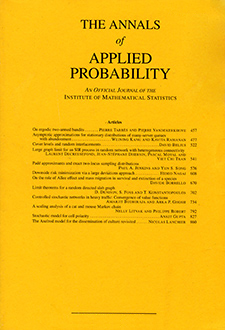Abstract
We consider the following distributed service model: jobs with unit mean, general distribution, and independent processing times arrive as a renewal process of rate $\lambda n$, with $0<\lambda <1$, and are immediately dispatched to one of several queues associated with $n$ identical servers with unit processing rate. We assume that the dispatching decisions are made by a central dispatcher endowed with a finite memory, and with the ability to exchange messages with the servers.
We study the fundamental resource requirements (memory bits and message exchange rate), in order to drive the expected queueing delay in steady-state of a typical job to zero, as $n$ increases. We develop a novel approach to show that, within a certain broad class of “symmetric” policies, every dispatching policy with a message rate of the order of $n$, and with a memory of the order of $\log n$ bits, results in an expected queueing delay which is bounded away from zero, uniformly as $n\to \infty $. This complements existing results which show that, in the absence of such limitations on the memory or the message rate, there exist policies with vanishing queueing delay (at least with Poisson arrivals and exponential service times).
Citation
David Gamarnik. John N. Tsitsiklis. Martin Zubeldia. "A lower bound on the queueing delay in resource constrained load balancing." Ann. Appl. Probab. 30 (2) 870 - 901, April 2020. https://doi.org/10.1214/19-AAP1519
Information





